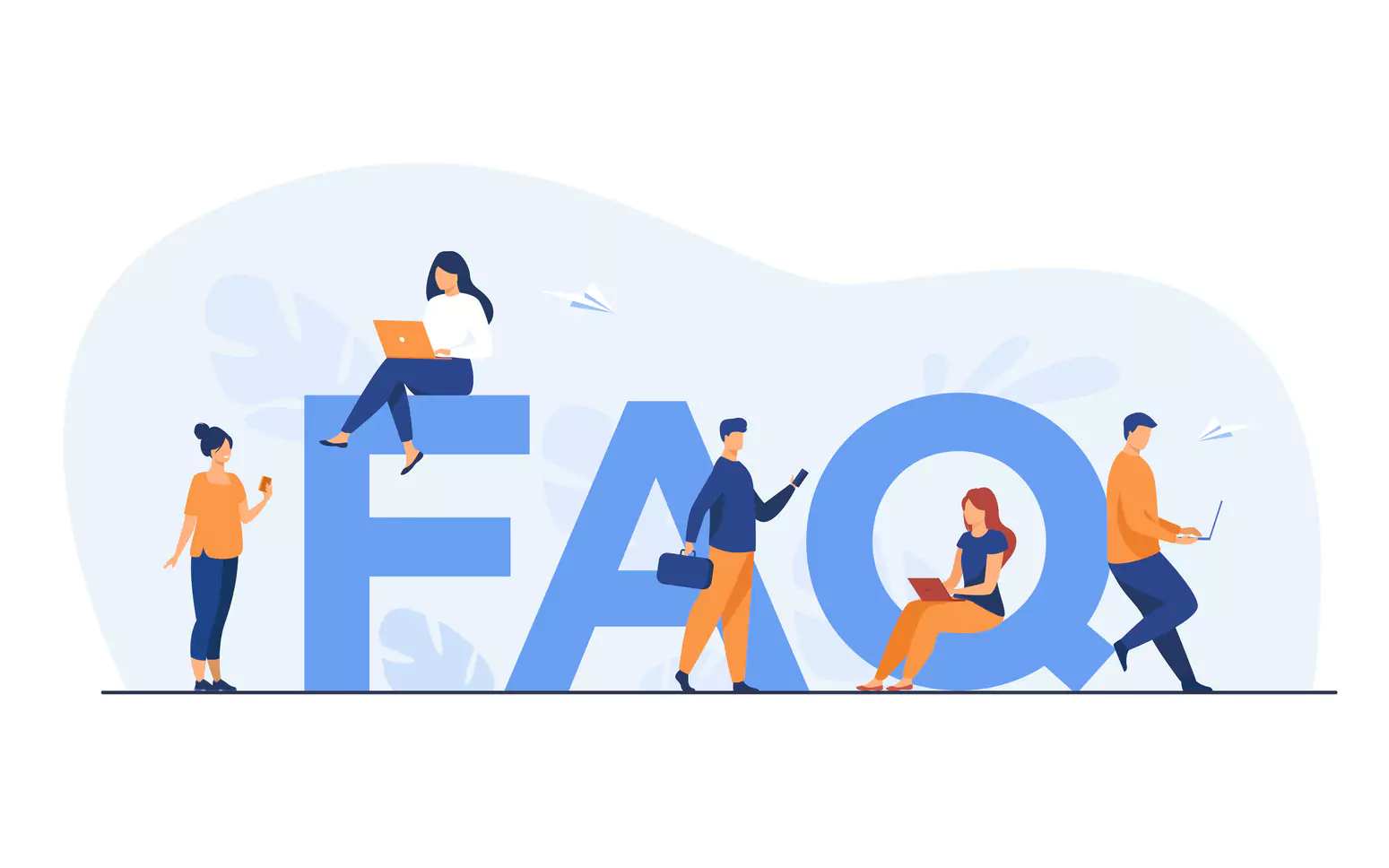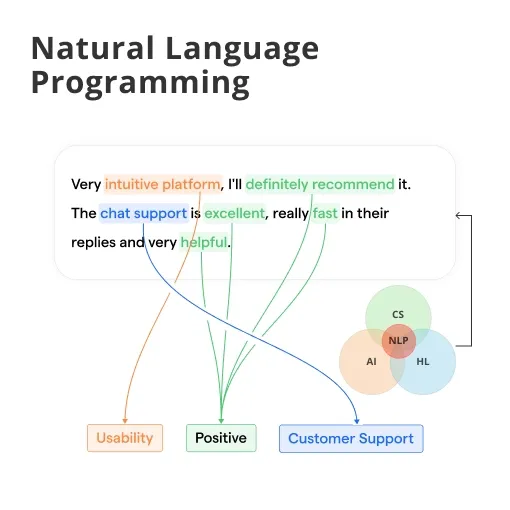What is NLP (Natural Language Programming)?
Natural Language Programming (NLP) is a branch of artificial intelligence (AI) that focuses on enabling computers to understand and generate human language. It involves developing algorithms, models, and systems that can interpret and respond to natural language input, such as text or speech. NLP encompasses various tasks, including language translation, sentiment analysis, chatbots, and information extraction.
By leveraging techniques like machine learning and deep learning, NLP algorithms can learn patterns and structures in language data, allowing them to comprehend and generate human-like responses.
NLP plays a crucial role in applications like voice assistants, customer support automation, and language processing for large-scale data analysis. It bridges the gap between human communication and computational systems, making it easier for people to interact with machines using everyday language.
How does NLP (Natural Language Programming) Work?
Tokenization and Text Preprocessing
NLP begins with breaking down text into words or tokens for further analysis. Preprocessing steps include removing punctuation and special characters, converting text to lowercase, and removing stop words or common words with little meaning.
Text Vectorization
To make text understandable to machines, it is converted into numerical vectors. Techniques like Bag of Words, TF-IDF, and Word Embeddings help in achieving this. These methods give meaning to individual words or phrases based on their frequency or context.
Feature Extraction and Selection
NLP algorithms need to identify the most important features from the text data. Dimensionality reduction techniques like PCA and LSA help remove redundant information and reduce the computational burden of large datasets.
Choosing and Training Machine Learning Models
Depending on the NLP task, a suitable machine learning model is chosen (e.g., linear regression, naive Bayes, or neural networks). These models are trained using the preprocessed and vectorized text data to learn patterns, classifications, or relationships within the text.
Model Evaluation and Testing
The trained models are tested on unseen data to check their performance on NLP tasks, such as sentiment analysis, summarization, or language translation. Evaluation metrics like accuracy, precision, and recall help determine if models need further tuning or optimization.
Why is NLP (Natural Language Programming) Important?
Bridging the Communication Gap
NLP (Natural Language Programming) is crucial as it allows a seamless interaction between humans and computers by programming in human language, which bridges the communication gap. It enables developers to design software and systems that understand instructions given in a natural language, making interactions simpler and more user-friendly.
Enhancing User Experience
Through NLP, software applications can understand and act upon user commands using natural language syntax. These become highly user-friendly, enhancing overall user experience and ensuring the software is accessible to a wider audience, thanks to the reduced need for technical knowledge.
Paving the Way for Innovation
NLP allows the creation of innovative software capable of understanding natural language, such as chatbots or AI assistants. These systems can perform tasks or answer questions communicated to them without requiring the user to learn any coding or technical language.
Encouraging Transparency
In specific use cases, such as autonomous robots, NLP allows the creation of transparent robots. These robots can reason in a manner transparent to the user, fostering trust between the machine and its human user.
Expanding Reach and Possibilities
Moreover, NLP enables the digitization and automation of tasks that traditionally relied solely on human intelligence to understand and process. By handling these tasks more effectively and efficiently, NLP opens up new possibilities across various industries, from customer service to healthcare and education.
Who Uses NLP?
Technology Companies
Many technology companies integrate NLP into their products and services. Companies like Google, Microsoft, and Amazon utilize NLP to power their voice assistants (Google Assistant, Alexa) and language processing applications. NLP enables these companies to understand user queries, provide accurate responses, and deliver a more natural and intuitive user experience.
Customer Service and Support
Businesses that offer customer service and support benefit from NLP applications. NLP-powered chatbots and virtual assistants can handle customer inquiries, provide instant responses, and even escalate complex issues to human agents when necessary. This helps streamline customer service processes, enhance efficiency, and improve customer satisfaction.
Healthcare and Medical Research
In the healthcare industry, NLP is used to analyze and extract information from medical records, research papers, and clinical notes. It helps healthcare professionals in tasks such as patient data analysis, disease diagnosis, and treatment recommendations. NLP also contributes to medical research by automating data extraction, enabling researchers to find relevant information quickly and efficiently.
E-commerce and Recommendation Systems
E-commerce platforms utilize NLP to enhance their recommendation systems. By analyzing customer reviews, search queries, and browsing behavior, NLP algorithms can understand customer preferences, identify patterns, and provide personalized product recommendations. This improves the shopping experience, increases customer engagement, and drives sales.
Financial Institutions
Financial institutions employ NLP to analyze and extract insights from vast amounts of textual data, including news articles, social media, and financial reports. NLP algorithms can detect sentiment, identify market trends, and provide valuable information for investment decision-making. NLP also aids in fraud detection by analyzing patterns in financial transactions and identifying suspicious activities. These are just a few examples of industries and sectors that utilize NLP to enhance their operations, improve user experiences, and gain valuable insights from large volumes of text-based data. The applications of NLP continue to expand as more businesses recognize its potential in various domains.
How is NLP Used?
Understanding User Intent and Sentiment Analysis
NLP is utilized to comprehend user intent and sentiment analysis in various applications. By analyzing the language used by users, NLP algorithms can determine the purpose behind their queries or statements.
This helps in providing more accurate and relevant responses, whether it's for customer support, virtual assistants, or social media monitoring. Sentiment analysis enables businesses to gauge customer opinions and sentiments, which can be valuable for reputation management and market research.
Machine Translation and Language Localization
NLP plays a crucial role in machine translation, allowing computers to automatically translate text or speech from one language to another. It helps bridge language barriers and facilitates communication between people who speak different languages.
NLP also enables language localization, which involves adapting software, websites, or content to specific regions or cultural contexts. It ensures that language nuances, idioms, and cultural references are accurately conveyed, providing a more personalized and user-friendly experience.
Information Extraction and Text Mining
NLP techniques are employed to extract relevant information and insights from unstructured text data. Information extraction involves identifying specific entities, relationships, or events within a document or a collection of documents.
This is valuable in applications like resume parsing, news aggregation, or extracting structured data from online sources. Text mining, on the other hand, involves analyzing large volumes of text to discover patterns, trends, or hidden knowledge. This is particularly useful in fields like market research, fraud detection, and content analysis.
Natural Language Generation
NLP is also used for natural language generation, where machines generate human-like text based on structured data or predefined rules.
This is seen in applications like automated report generation, personalized emails, or chatbot responses. By employing NLP techniques, the generated text can be coherent, contextually relevant, and tailored to individual users or situations. Natural language generation enables automation of repetitive writing tasks and facilitates personalized and scalable communication.
Voice Assistants and Conversational Interfaces
One of the most prevalent applications of NLP is in voice assistants and conversational interfaces. NLP algorithms enable devices like smart speakers or mobile assistants to understand and respond to voice commands or queries.
By leveraging speech recognition, natural language understanding, and dialogue management, these systems provide hands-free and intuitive interaction. NLP enables voice assistants to perform tasks like setting reminders, answering questions, playing music, or controlling smart home devices. The goal is to create seamless and human-like conversational experiences, enhancing user convenience and productivity.
NLP vs. NLU
Definition of NLP and NLU
Natural Language Processing (NLP) is a subfield of Artificial Intelligence (AI) focused on understanding, interpreting, and generating human language. It enables computers to process text and speech intelligently and meaningfully. On the other hand, Natural Language Understanding (NLU) is a component within NLP that zeroes in on comprehending the meaning, context, and intent behind human language.
NLP Techniques
NLP relies on various techniques such as tokenization, stemming, syntax analysis, and topic modeling to process and analyze language. These techniques help convert raw text or speech data into structured formats, making them suitable for machine processing and analysis.
NLU Techniques
NLU, on the other hand, focuses on extracting specific information, interpreting context, and determining intent. Techniques commonly used in NLU include entity recognition, sentiment analysis, and intent classification.
NLP Applications
Examples of NLP applications include translation services, document classification, and sentiment analysis, to name a few. NLP solutions are widely used in chatbots, search engines, voice assistants, and other language-based applications.
NLU Applications
NLU applications involve understanding the context and meaning of natural language input, making them vital for applications like voice assistants, chatbots, and AI-driven customer service systems. The primary purpose of NLU is to comprehend user intentions or requirements better and provide more relevant, accurate information or responses.
NLP Challenges
Context and Co-reference Resolution
Understanding context is a critical challenge in NLP. Words can carry different meanings in different contexts, posing difficulty for machines. Co-reference resolution, which is recognizing when two words refer to the same entity in a sentence or across sentences, is another difficult task.
Handling Ambiguity and Sarcasm
Natural language is inherently ambiguous, and humans use various clues to disambiguate. NLP struggles with such ambiguities. Detecting sarcasm, which often relies on context and tone of voice, is particularly challenging, especially in written text.
Linguistic Diversity and Multilingual Support
Supporting multiple languages is not straightforward due to differences in grammar, dialects, and writing systems. Building models for less resourced languages is even more challenging due to the lack of quality datasets.
Implicit Information and Inference
People often leave certain information unsaid, assuming it will be implicitly understood based on context. This requires a level of inference that is exceptionally tough for machines as they lack the ability to "understand" in the way humans do.
Understanding Human Sentiment
Understanding the emotional tone of text is a complex NLP challenge. The use of colloquial language, ironic statements, emojis, and other nuanced cues to express sentiment often present difficulties for NLP models.
Frequently Asked Questions

What is Natural Language Programming?
Natural Language Programming is a type of programming language designed to interact with computers using human-readable language, making programming more intuitive and accessible to non-programmers.
What are some examples of Natural Language Programming?
Examples of Natural Language Programming systems include ChatScript, Inform 7, and Wolfram Language. These tools allow programming using more human-like syntax.
How does Natural Language Programming work?
Natural Language Programming works by translating human language into commands that a computer can understand and execute. This involves complex linguistic and semantic analysis.
What are the advantages of Natural Language Programming?
Natural Language Programming can make programming more accessible to non-programmers, enhance software usability, and facilitate more intuitive human-computer interaction.
Are there limitations to Natural Language Programming?
While powerful, Natural Language Programming has limitations. Notably, the ambiguity and complexity of human language can lead to misunderstandings or incorrect interpretations by the system.



